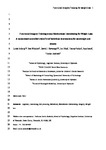Functional Imagery Training versus Motivational Interviewing for Weight Loss: A randomised controlled trial of brief individual interventions for overweight and obesity
| dc.contributor.author | Solbrig, L | |
| dc.contributor.author | Whalley, B | |
| dc.contributor.author | Kavanagh, DJ | |
| dc.contributor.author | May, J | |
| dc.contributor.author | Parkin, T | |
| dc.contributor.author | Jones, R | |
| dc.contributor.author | Andrade, J | |
| dc.date.accessioned | 2018-04-24T19:00:12Z | |
| dc.date.issued | 2018-09-05 | |
| dc.identifier.issn | 0307-0565 | |
| dc.identifier.issn | 1476-5497 | |
| dc.identifier.uri | http://hdl.handle.net/10026.1/11340 | |
| dc.description.abstract |
OBJECTIVE: Functional Imagery Training (FIT) is a new brief motivational intervention based on the Elaborated Intrusion theory of desire. FIT trains the habitual use of personalised, affective, goal-directed mental imagery to plan behaviours, anticipate obstacles, and mentally try out solutions from previous successes. It is delivered in the client-centred style of Motivational Interviewing (MI). We tested the impact of FIT on weight loss, compared with time- and contact-matched MI. DESIGN: We recruited 141 adults with BMI (kg/m²) ≥25, via a community newspaper, to a single-centre randomised controlled trial. Participants were allocated to one of two active interventions: FIT or MI. Primary data collection and analyses were conducted by researchers blind to interventions. All participants received two sessions of their allocated intervention; the first face-to-face (1 h), the second by phone (maximum 45 min). Booster calls of up to 15 min were provided every 2 weeks for 3 months, then once-monthly until 6 months. Maximum contact time was 4 h of individual consultation. Participants were assessed at Baseline, at the end of the intervention phase (6 months), and again 12 months post-baseline. MAIN OUTCOME MEASURES: Weight (kg) and waist circumference (WC, cm) reductions at 6 and 12 months. RESULTS: FIT participants (N = 59) lost 4.11 kg and 7.02 cm of WC, compared to .74 kg and 2.72 cm in the MI group (N = 55) at 6 months (weight mean difference (WMD) = 3.37 kg, p < .001, 95% CI [-5.2, -2.1], waist-circumference mean difference (WCMD) = 4.3 cm, p < .001, 95% CI [-6.3,-2.6]). Between-group differences were maintained and increased at month 12: FIT participants lost 6.44 kg (W) and 9.1 cm (WC) compared to the MI who lost .67 kg and 2.46 cm (WMD = 5.77 kg, p < .001, 95% CI [-7.5, -4.4], WCMD = 6.64 cm, p < .001, 95% CI [-7.5, -4.4]). CONCLUSION: FIT is a theoretically informed motivational intervention which offers substantial benefits for weight loss and maintenance of weight reduction, compared with MI alone, despite including no lifestyle education or advice. | |
| dc.format.extent | 883-894 | |
| dc.format.medium | Print-Electronic | |
| dc.language | en | |
| dc.language.iso | en | |
| dc.publisher | Nature Publishing Group | |
| dc.subject | Adult | |
| dc.subject | Aged | |
| dc.subject | Diet, Reducing | |
| dc.subject | Female | |
| dc.subject | Humans | |
| dc.subject | Imagery, Psychotherapy | |
| dc.subject | Male | |
| dc.subject | Middle Aged | |
| dc.subject | Models, Psychological | |
| dc.subject | Motivational Interviewing | |
| dc.subject | Obesity | |
| dc.subject | Overweight | |
| dc.subject | Patient Compliance | |
| dc.subject | Weight Loss | |
| dc.title | Functional Imagery Training versus Motivational Interviewing for Weight Loss: A randomised controlled trial of brief individual interventions for overweight and obesity | |
| dc.type | journal-article | |
| dc.type | Article | |
| plymouth.author-url | https://www.ncbi.nlm.nih.gov/pubmed/30185920 | |
| plymouth.issue | 4 | |
| plymouth.volume | 43 | |
| plymouth.publication-status | Published | |
| plymouth.journal | International Journal of Obesity | |
| dc.identifier.doi | 10.1038/s41366-018-0122-1 | |
| plymouth.organisational-group | /Plymouth | |
| plymouth.organisational-group | /Plymouth/Admin Group - REF | |
| plymouth.organisational-group | /Plymouth/Admin Group - REF/REF Admin Group - FoH | |
| plymouth.organisational-group | /Plymouth/Faculty of Health | |
| plymouth.organisational-group | /Plymouth/Faculty of Health/School of Health Professions | |
| plymouth.organisational-group | /Plymouth/Faculty of Health/School of Nursing and Midwifery | |
| plymouth.organisational-group | /Plymouth/Faculty of Health/School of Psychology | |
| plymouth.organisational-group | /Plymouth/REF 2021 Researchers by UoA | |
| plymouth.organisational-group | /Plymouth/REF 2021 Researchers by UoA/UoA03 Allied Health Professions, Dentistry, Nursing and Pharmacy | |
| plymouth.organisational-group | /Plymouth/REF 2021 Researchers by UoA/UoA04 Psychology, Psychiatry and Neuroscience | |
| plymouth.organisational-group | /Plymouth/REF 2021 Researchers by UoA/UoA04 Psychology, Psychiatry and Neuroscience/UoA04 REF peer reviewers | |
| plymouth.organisational-group | /Plymouth/Research Groups | |
| plymouth.organisational-group | /Plymouth/Research Groups/Centre for Brain, Cognition and Behaviour (CBCB) | |
| plymouth.organisational-group | /Plymouth/Research Groups/Centre for Brain, Cognition and Behaviour (CBCB)/Behaviour | |
| plymouth.organisational-group | /Plymouth/Research Groups/Centre for Brain, Cognition and Behaviour (CBCB)/Cognition | |
| plymouth.organisational-group | /Plymouth/Research Groups/Institute of Health and Community | |
| plymouth.organisational-group | /Plymouth/Research Groups/Plymouth Institute of Health and Care Research (PIHR) | |
| plymouth.organisational-group | /Plymouth/Users by role | |
| plymouth.organisational-group | /Plymouth/Users by role/Academics | |
| dc.publisher.place | England | |
| dcterms.dateAccepted | 2018-04-10 | |
| dc.rights.embargodate | 2019-3-5 | |
| dc.identifier.eissn | 1476-5497 | |
| dc.rights.embargoperiod | Not known | |
| rioxxterms.versionofrecord | 10.1038/s41366-018-0122-1 | |
| rioxxterms.licenseref.uri | http://www.rioxx.net/licenses/all-rights-reserved | |
| rioxxterms.licenseref.startdate | 2018-09-05 | |
| rioxxterms.type | Journal Article/Review |


